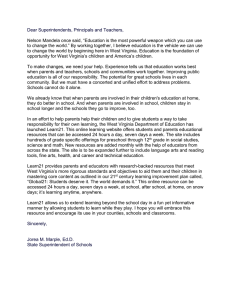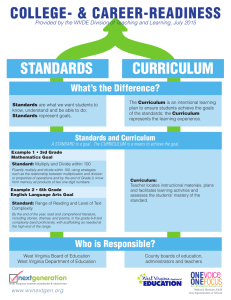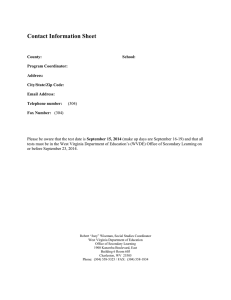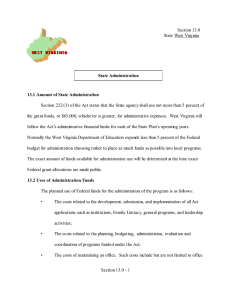The West Virginia Professional Growth Guides
advertisement
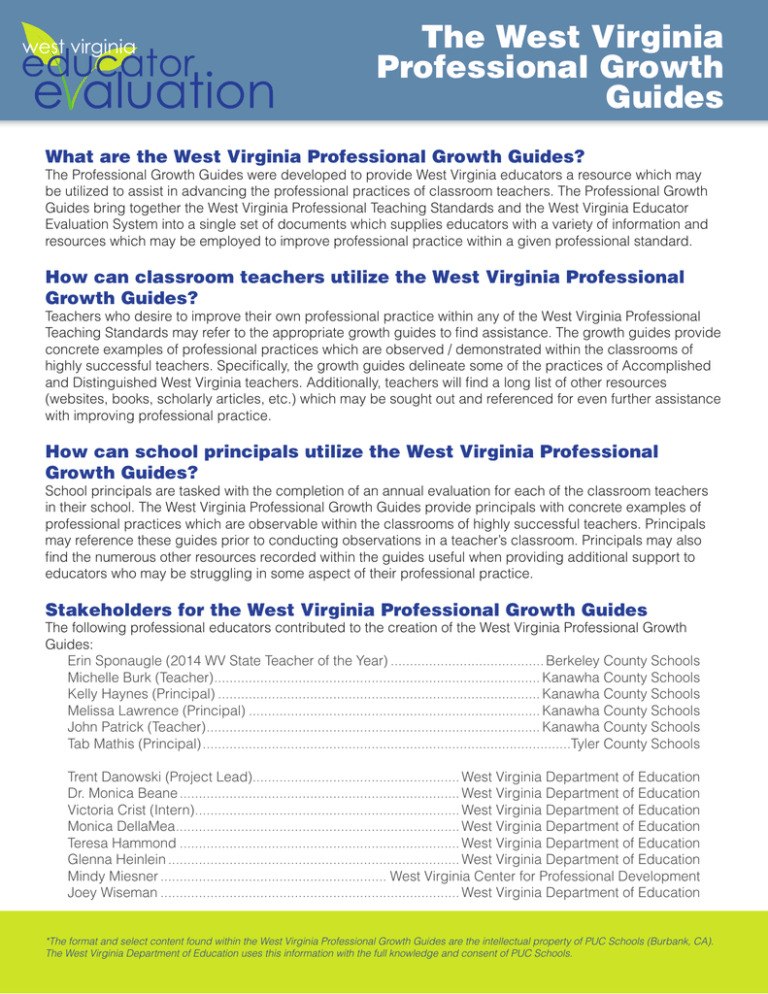
The West Virginia Professional Growth Guides What are the West Virginia Professional Growth Guides? The Professional Growth Guides were developed to provide West Virginia educators a resource which may be utilized to assist in advancing the professional practices of classroom teachers. The Professional Growth Guides bring together the West Virginia Professional Teaching Standards and the West Virginia Educator Evaluation System into a single set of documents which supplies educators with a variety of information and resources which may be employed to improve professional practice within a given professional standard. How can classroom teachers utilize the West Virginia Professional Growth Guides? Teachers who desire to improve their own professional practice within any of the West Virginia Professional Teaching Standards may refer to the appropriate growth guides to find assistance. The growth guides provide concrete examples of professional practices which are observed / demonstrated within the classrooms of highly successful teachers. Specifically, the growth guides delineate some of the practices of Accomplished and Distinguished West Virginia teachers. Additionally, teachers will find a long list of other resources (websites, books, scholarly articles, etc.) which may be sought out and referenced for even further assistance with improving professional practice. How can school principals utilize the West Virginia Professional Growth Guides? School principals are tasked with the completion of an annual evaluation for each of the classroom teachers in their school. The West Virginia Professional Growth Guides provide principals with concrete examples of professional practices which are observable within the classrooms of highly successful teachers. Principals may reference these guides prior to conducting observations in a teacher’s classroom. Principals may also find the numerous other resources recorded within the guides useful when providing additional support to educators who may be struggling in some aspect of their professional practice. Stakeholders for the West Virginia Professional Growth Guides The following professional educators contributed to the creation of the West Virginia Professional Growth Guides: Erin Sponaugle (2014 WV State Teacher of the Year)......................................... Berkeley County Schools Michelle Burk (Teacher)...................................................................................... Kanawha County Schools Kelly Haynes (Principal)..................................................................................... Kanawha County Schools Melissa Lawrence (Principal)............................................................................. Kanawha County Schools John Patrick (Teacher)........................................................................................ Kanawha County Schools Tab Mathis (Principal).................................................................................................Tyler County Schools Trent Danowski (Project Lead)...................................................... West Virginia Department of Education Dr. Monica Beane.......................................................................... West Virginia Department of Education Victoria Crist (Intern)...................................................................... West Virginia Department of Education Monica DellaMea........................................................................... West Virginia Department of Education Teresa Hammond.......................................................................... West Virginia Department of Education Glenna Heinlein............................................................................. West Virginia Department of Education Mindy Miesner............................................................ West Virginia Center for Professional Development Joey Wiseman............................................................................... West Virginia Department of Education *The format and select content found within the West Virginia Professional Growth Guides are the intellectual property of PUC Schools (Burbank, CA). The West Virginia Department of Education uses this information with the full knowledge and consent of PUC Schools. The West Virginia Professional Growth Guides STANDARD 3: TEACHING Element 3.2. - The teacher motivates and engages students in learning, problem-solving, and collaboration Description: The teacher creates and maintains a positive, supportive classroom climate, and communicates with students in a variety of ways. The teacher delivers instruction to motivate and engage students in a deep understanding of the content. The instructional delivery methods and tools are appropriate for the type of learning target, and the teacher facilitates a challenging and active learning environment which encourages students to make decisions regarding their own learning. The teacher practices quality questioning techniques and engages students in discussion. Excitement about learning is not only demonstrated in the instruction, but also the engagement of the students in learning activities that are relevant and based on individual needs and learning characteristics. Connection to College & Career Readiness / Next Generation Standards: Connections to Professional Teaching Standard 3 - Teaching • Teacher provides educational opportunities for students to achieve high levels of learning through approved content standards and objectives, and 21st century learning skills and technology tools that prepare students to be lifelong learners and successful citizens in a competitive global society. • Teacher uses multiple learning and teaching approaches resulting in authentic student engagement in active and purposeful learning. • Teacher employs formative assessment processes to guide daily instruction. Appropriate formative assessments provide data to the teacher and inform future classroom instruction. Various forms of evidence demonstrate the students’ progressions of learning across content areas; evidence is utilized to personalize the learning experience. • Students learn and understand important concepts, develop essential skills, and apply what they learn to real-world problems. Professional practices within this standard-element: At the Distinguished Level The classroom provides a safe environment for student discussions which allow students to learn from their own mistakes or misconceptions. Lessons and unit plans consistently incorporate the known interests and abilities of students (as motivation or 21st century context ). Technology utilized within a lesson consistently elevates student learning to the application, analysis, and synthesis levels. The teacher prepares students (through modeling) for how to appropriately lead and initiate learning activities. Students are provided a framework for how to collaborate in a group. Student led activities dominate the classroom environment (i.e. Student led conferences, student directed instruction, rubric creation and self-evaluation strategies). The West Virginia Professional Growth Guides At the Accomplished Level The teacher serves primarily as a facilitator providing modeling, collaborative grouping, and rubric building. Lessons and unit plans often incorporate the known interests and abilities of students (as motivation or 21st century context ). Technology is utilized in student problem solving and in the creation of student projects. Students are provided a framework for how to collaborate in a group. Students are provided opportunities for collaborative and/or project-based learning on a regular basis. The teacher guides students toward a deeper understanding of the content. Common Misconceptions or Difficulties: Cognitive engagement refers to students being interested in what I am teaching While student interest and investment is certainly an important element of cognitive engagement, it only addresses the engagement part, not the cognition. While students may be quite engaged by watching the Smurfs dig a canal, this activity all by itself will probably not result in much cognitive engagement. If students are asked before watching to analyze how the Smurfs are applying principles from the unit of study, reminded to use resources to answer the question, and told to be prepared to discuss afterwards, students may actually be cognitively engaged. I don’t know how to make review tasks engaging Part of cognitive engagement is having students persist in acquiring knowledge by accessing tools independently. You have probably chosen certain questions for review based on your data. If you know they haven’t memorized the material yet, what tools can students use to find the answers? Have you encouraged them to use notes or textbooks to find answers they don’t know (and have shown them how to do this)? Are there wall charts they can refer to? Perhaps one of the questions can be open-ended to discover what they do know. Finally, if you know the activity isn’t cognitively engaging, it may not be worth the time spent on it. I gave students the information, and now they need to remember it. These are facts that they just need to know. I don’t have time to linger with this information. Sometimes this seems like the most efficient way to deliver instruction, but without having some way for students to independently synthesize the information, there are only low levels of cognition involved. If students are required to write about how the new information connects with previous information or problem solve with the new information, then they are engaging in higher levels of cognition, which is far more likely to be retained long-term. Professional Development Strategies: • As an individual or group »» Create a list of strategies for this standard-element which are specific to your grade level or content area. »» Observe a peer teacher, then describe promising instructional practices relevant to this standardelement. »» Incorporate strategies for this standard-element into an instructional plan. Think about lesson objectives that lend themselves to various levels of rigor and create options for students. Ask for feedback on this lesson from a colleague or instructional leader. The West Virginia Professional Growth Guides • As a group »» Discuss this standard-element and Growth Guide within the context of your school goals. Work together to construct criteria that would describe engaging learning experiences. »» Review existing practices and strategies being utilized in your school related to this standardelement. Brainstorm new practices which can be utilized. »» List steps which educators in your school can employ to become more proficient within this standard-element. Resources: • Websites & Videos »» Educational Impact (www.educationalimpact.com) – Resources include a wide range of professional development modules/videos. Content aligned specifically to the West Virginia Professional Teaching Standards is available. Contact your school principal or your District / RESA central office to inquire about availability at your school. »» Edutopia (http://www.edutopia.org/teacher-development) – A comprehensive website and online community that increases knowledge, sharing, and adoption of what works in K-12 education. »» EngageNY (www.engageny.org) - Resource topics include: The Common Core Standards, Teacher/Leader Effectiveness, Data Driven Instruction, Professional Development (All Grade Levels), and a Video Library. »» Achieve The Core (www.achievethecore.org) – Resource topics include Common Core instructional resources for ELA/Literacy and Mathematics, Leadership Tools relating to the Common Core Standards. »» School Improvement Network (http://www.schoolimprovement.com)- Professional learning resources designed to help teachers and administrators become even more effective in their educational practices. »» TeacherTube (www.teachertube.com) – Video, audio, and document resources on a wide range of searchable topics. »» Teacher Vision (http://www.teachervision.com/pro-dev/resource/5778.html -A wide range of professional development resources for educators including articles, lesson plans, and other resources from notable publishers and experts in the field. »» The Teaching Channel (www.teachingchannel.org) – Videos and other resources searchable by topic. »» All Things PLC (www.allthingsplc.info) – Variety of research articles, documents, tools, and other resources. • Readings »» Alexander, Patricia. (2005). Psychology in Learning and Instruction. Pearson. »» Cain, Sean and Laird, Mike. (2011). The Fundamental “5”: The Formula for Quality Instruction. Independent Publishing Platform. »» Coffman, Teresa. (2013). Using Inquiry in the Classroom: Developing Creative Thinkers and Information Literate Students. Rowan and Littlefield Publishers, Inc. »» Frey, Nancy. (2009). The Effective Teacher’s Guide: 50 Ways for Engaging Students in Learning. Academic Professional Development »» Hammond, Linda Darling, et. al. (2008). Powerful Learning: What We Know About Teaching for Understanding. Wiley The West Virginia Professional Growth Guides »» Irby, Beverly & Lunenburg, Fredrick. (2011). Instructional Strategies to Facilitate Learning. International Journal of Education Leadership Preparation. Retrieved from http://files.eric.ed.gov/ fulltext/EJ974330.pdf »» Lemov, Doug. (2010). Teach Like a Champion: 49 Techniques That Put Students on the Path to College. San Francisco, CA: Jossey-Bass. See: Challenging Students to Think Critically: Additional Techniques for Questioning and Responding to Students »» Marzano, Robert, Pickering Debra, & Pollock, Jane. (2001). Classroom Instruction That Works: Researched-Based Strategies for Increasing Student Achievement. Alexandria, VA: ASCD »» Marzano, Robert. (2010). Teaching Inference. ASCD. Retrieved from http://www.ascd.org/ publications/educational-leadership/apr10/vol67/num07/Teaching-Inference.aspx »» Strebe, John. (2014). Engaging Mathematics Students Using Cooperative Learning. Routledge »» Zemelman, Steve; Daniels, Harvey; Hyde, Arthur. (2012). Best Practice: Bringing Standards to Life in America’s Classrooms. Portsmouth, NH: Heinemann • Planning Resources »» Office of Early Learning, West Virginia Department of Education. Guidance Documents for PreK5th Grade levels http://wvde.state.wv.us/oel/ »» Office of Secondary Learning, West Virginia Department of Education. Resources for Standardsbased Units, Project-based Learning, Standards-based Instruction, and 21st Century Instruction are available. http://wvde.state.wv.us/instruction/ »» West Virginia Center for Professional Development. Resources include, but are not limited to, the following trainings: • Teacher Academy-Provides research-based materials and instructional strategies to help strengthen teaching • Coaching/Mentoring Programs-Guides professional development of educational leaders to improve school and classroom practices • Advanced Placement Summer Institutes-Learning and support for teachers of Advanced Placement Courses • Safe and Supportive Schools-Addresses aspects of school climate and culture using WVDE’s School Climate Survey and the WVEIS Discipline Module • Infusing Technology-Helps educators transform the use of technological tools into powerful devices for instruction and student engagement in order to increase critical thinking, reasoning, and problem solving skills • National Board Certification Support-Ongoing support for NBC candidates throughout the process of completing the four (4) components Please visit http://www.wvcpd.org for more information on training topics, dates, locations, and times.
